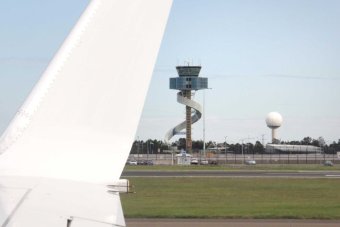With all of the chaos on the ground at Sydney Airport, from the skies pilots described "a ghost town".
Rarely do you see such little aviation traffic on a Monday morning in peak hour.

The ABC has been told the fault causing the delays related to a flight planning system.
The information from this feeds into the radar picture on controllers' screens — and without it, they can't tell which plane is which.
But failures in these systems — and the controller/pilot responses —are constantly rehearsed so that when they go down, everyone's prepared.
The organisation which runs air traffic control in Australia — Airservices Australia — has undertaken a major cost cutting program, leaving the organisation with 700 fewer staff.
It always maintained its decision would not impact aviation safety or frontline staff, but no doubt the investigation into today's incident will have to consider whether the cuts played a role.
The ABC has previously reported on radar faults in critical plane tracking systems at Sydney Airport.
Last year, the Wide Area Multilateration (WAM) system failed 15 times in one month alone, prompting serious concerns among air traffic controllers.
The WAM is one of several sophisticated surveillance systems which track planes in the sky.
But the failures meant that planes disappeared from one screen and were only visible on a slower updating radar.
Airservices Australia said it had several levels of redundancy in all of its systems and it is understood the issue has now been fixed.
The failures resulting in today's delays are not believed to be related to the WAM system.
While these delays are an inconvenience for passengers — the highly skilled controllers responded in a textbook way.
They constantly prepare for these situations, and it's a blessing that the failure happened at 5:20am, before the airport's 6:00am curfew was lifted and plane movements hit their peak.
As one controller said: "I've seen one of these before at peak hour and it wasn't pretty. It was probably 10-plus years ago. Failures of [systems] like this are extremely rare."
But when they do — they can have major impacts.
n this case it's major delays — and aviation is underpinned by multiple levels of backup to ensure the failure of one single system cannot cause a catastrophic failure.
Ground delay programs were activated — which means aircraft at other airports like Brisbane and Melbourne remained on the tarmac while movement capacity was limited in Sydney.
For those waiting to start their holidays, it might feel like a pain but it's a far less damaging result than an accident.
Source:
http://www.abc.net.au/news/2017-09-25/sydney-airport-delays-are-better-than-an-accident/8981234
Hi! I am a robot. I just upvoted you! I found similar content that readers might be interested in:
http://www.abc.net.au/news/2017-09-25/sydney-airport-delays-are-better-than-an-accident/8981234
Downvoting a post can decrease pending rewards and make it less visible. Common reasons:
Submit